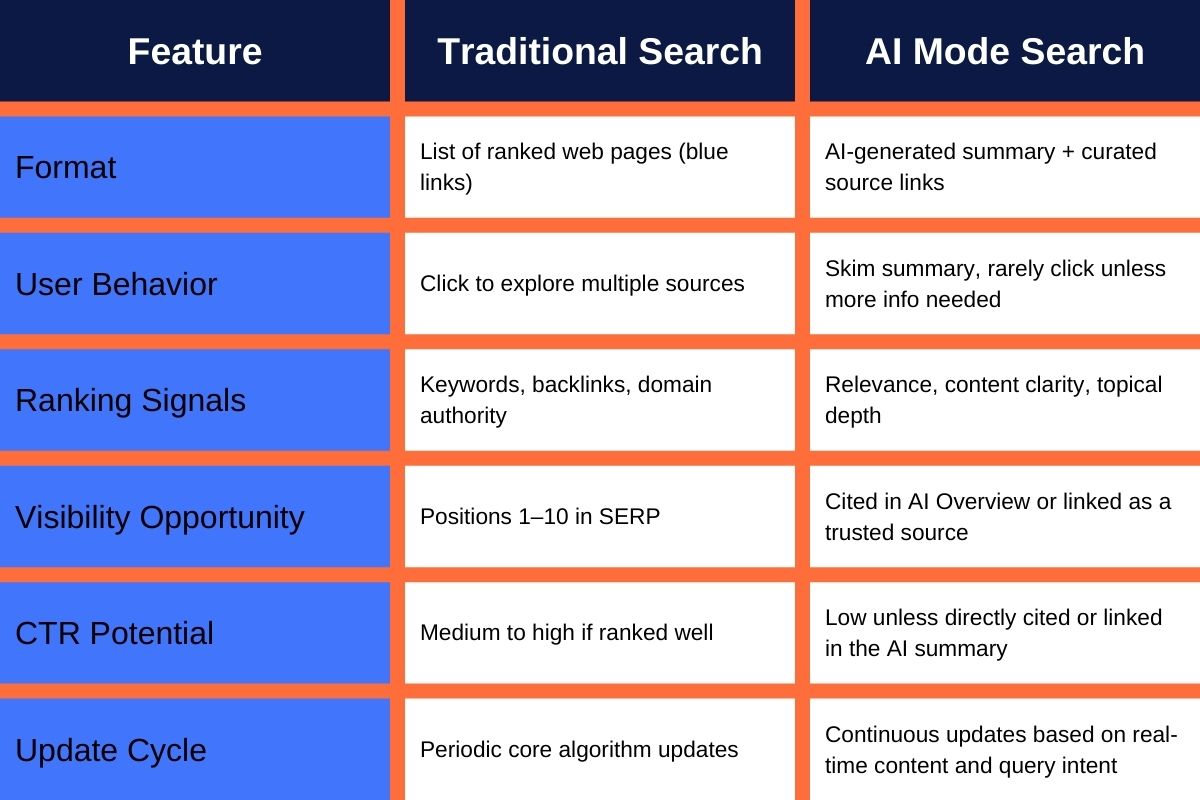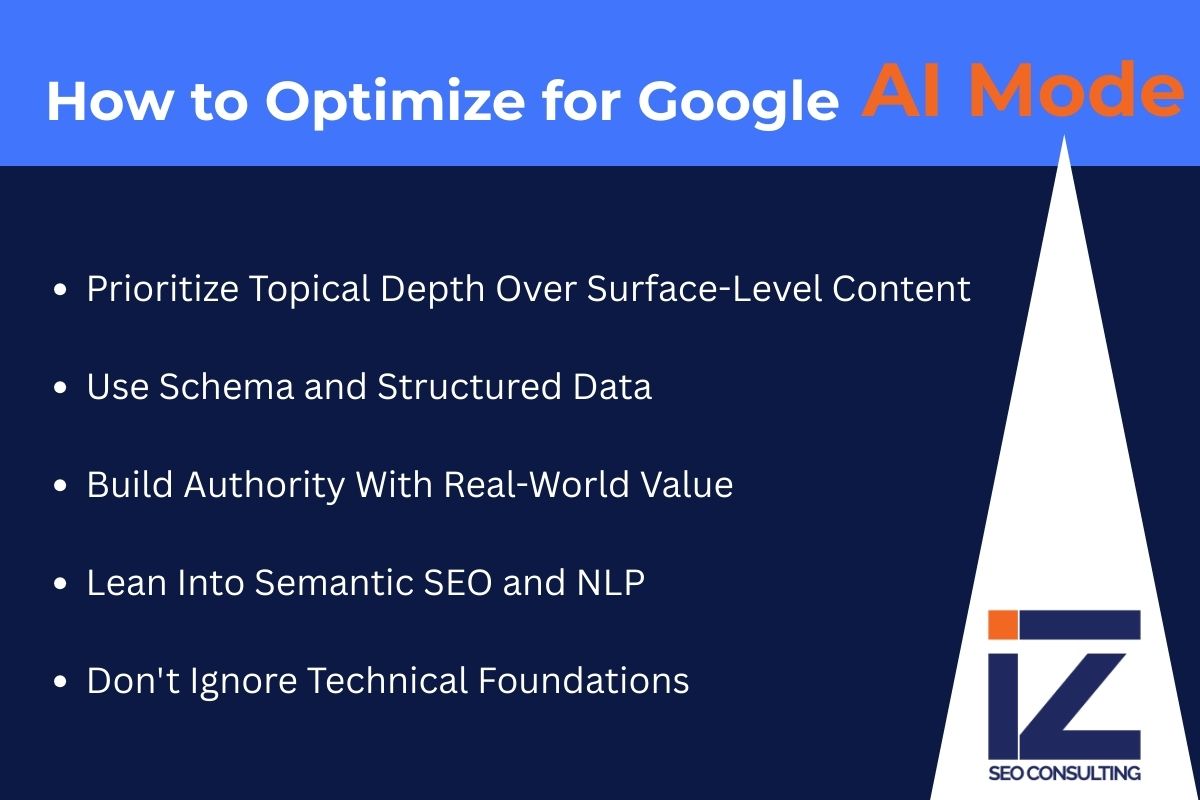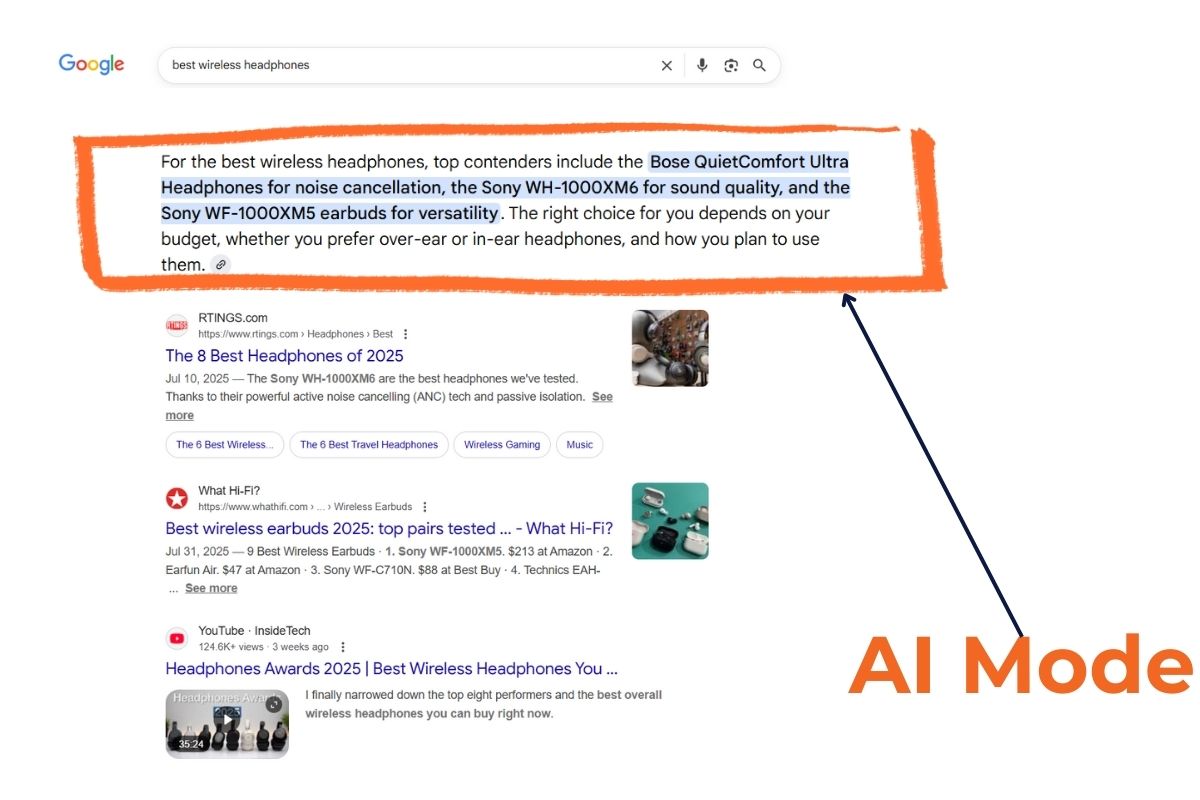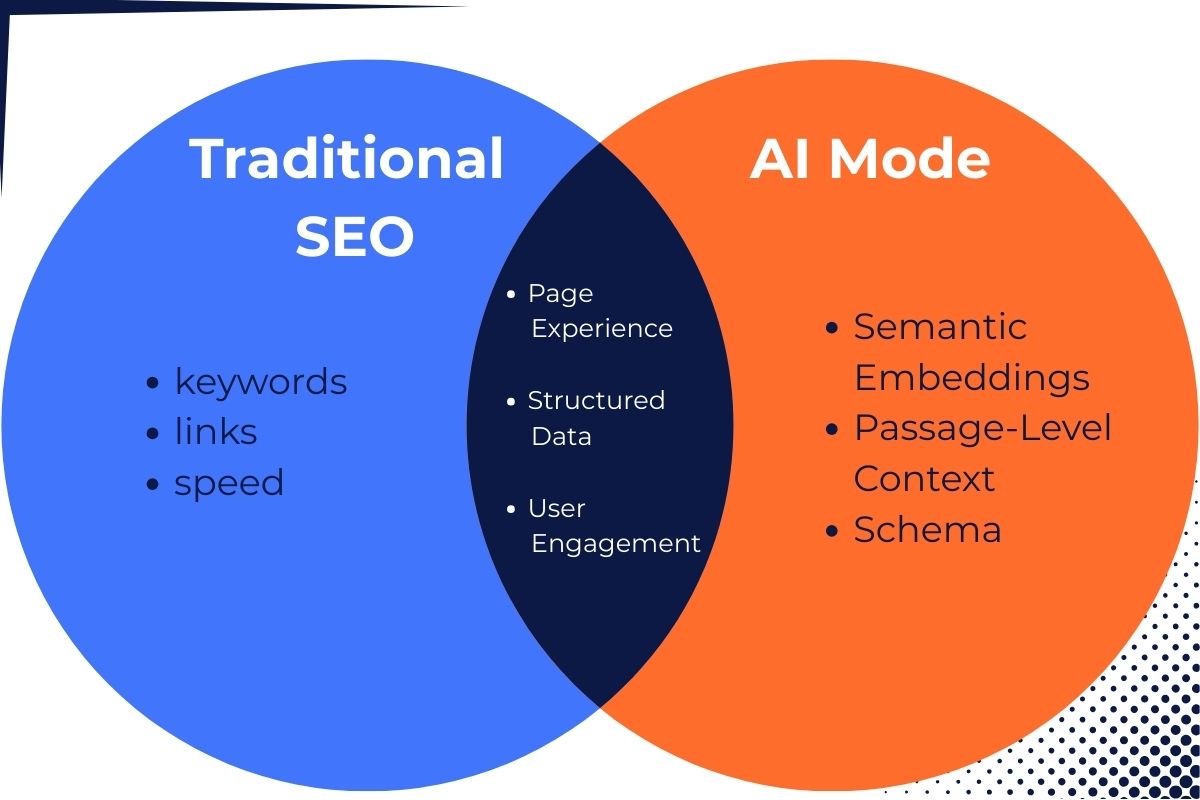With the rollout of Google AI Mode, experts are witnessing the entire SEO playbook being rewritten. Digital marketers whose SEO strategies still hinge on keyword stuffing, meta tag tinkering, and ranking in the top 10 blue links face a critical decision: adapt or fall behind. The age of Google AI mode SEO has arrived, fundamentally redefining how search functions.
What Is Google AI Mode—and How Will It Change SEO?
Google AI Mode represents far more than another algorithm update. SEO professionals describe it as a fundamental shift in how information gets retrieved, ranked, and displayed. The system blends large language models (like Gemini) with search technology to deliver more dynamic, conversational results. Traditional link-based SERPs are being supplemented—and sometimes replaced—by AI-generated overviews, summaries, and direct answers.

Industry analysts have identified several key implications:
- Less real estate for organic links. AI Overviews push traditional rankings down the fold.
- Intent over keywords. Matching user intent now trumps exact keyword matching.
- New ranking signals. Engagement metrics, topical authority, and structured data carry significantly more weight.
- Product reviews and experience-based content gain priority, especially with the enhanced focus on EEAT (Experience, Expertise, Authoritativeness, Trustworthiness).
- Highly personalized results. AI Mode adapts to search history, context, and previous queries to serve individualized results.
- Paid results and shopping integrations. Advertisements and product listings now surface directly inside AI Overviews.
The Google AI mode impact on SEO has proven massive. Many website owners report traffic drops—not because they committed SEO errors, but because the fundamental rules have changed.
What Is GEO and AEO—and Why They Matter Now
Two concepts have become central to AI-first SEO strategies: Generative Engine Optimization (GEO) and Answer Engine Optimization (AEO).
GEO focuses on optimizing content for AI engines that generate responses—like Google’s AI Mode. Unlike traditional search engines that rank and list pages, generative engines compose answers by pulling bits of content from various sources. Content creators must ensure their material is contextually rich, clearly structured, and built to be referenced or quoted.
AEO centers on making content eligible to be pulled into direct answers—also known as snippets or AI overviews. This approach requires content that directly and clearly answers common questions, uses structured formats like lists or FAQs, and includes proper schema markup so search engines understand its purpose.
Instead of simply trying to rank high, these approaches aim to ensure AI systems utilize the content—even when it doesn’t appear in the top 3 results.
Tools like Profound, Athena, and Scrunch AI are emerging to help businesses monitor and improve their AI visibility. This represents a rapidly growing ecosystem.
How to Optimize for Google AI Mode Today

1. Prioritize Topical Depth Over Surface-Level Content
AI-generated overviews pull from sources that demonstrate depth, authority, and real-world knowledge. This means:
- Creating clusters of related content (pillar + subpages)
- Going beyond definitions to show applications, examples, and scenarios
- Including real data, first-hand experience, and credible citations
2. Use Schema and Structured Data
Google AI mode SEO relies heavily on structured data to understand and extract content effectively.
- Mark up FAQs, reviews, products, and how-tos
- Use technical SEO best practices to ensure crawlability
- Optimize for entities, not just keywords
3. Build Authority With Real-World Value
Google is doubling down on Experience and Expertise requirements.
- Highlight author bios with real credentials
- Add unique perspectives, case studies, or test results
- Encourage user interaction—comments, votes, etc.—to boost engagement signals
4. Lean Into Semantic SEO and NLP
Content creators should use semantically related phrases and structure their content like an answer, not an article. This helps align with how AI understands and ranks content.
5. Don’t Ignore Technical Foundations
Even in the AI-first world, your site’s technical health still matters. AI systems rely on a clean, accessible structure to interpret and extract information accurately. If your site is slow, poorly structured, or hard to crawl, it’s less likely to be included in AI-generated responses.
How to Get Your Content Into AI-Generated Overviews
AI-generated overviews are summaries created by Google’s AI to directly answer search queries using content from multiple trusted sources. They appear at the very top of the search results page—often above everything else—and provide instant value to users without requiring a click.
SEO experts have identified how content makes it into these overviews:
Google’s AI looks for content that:
- Directly answers a specific question in a clear, concise format (2–4 sentence paragraphs, FAQs, lists)
- Is structured using proper schema markup
- Comes from a high-authority domain with EEAT signals (Experience, Expertise, Authoritativeness, Trustworthiness)
- Uses natural language, not SEO-stuffed copy
- Provides unique value—data, personal insight, stats, or firsthand examples
Pro tip: The AI doesn’t show just one source—it blends answers. This means even smaller or newer sites can be cited if the content is clean, relevant, and useful.

Content creators can improve their odds by focusing on these formats:
- Step-by-step tutorials
- FAQs and definitions
- Comparison tables
- Short paragraphs with clear intent
- Pages built around common user questions (“how to,” “what is,” “best way to”)
Getting into an AI Overview won’t always bring tons of clicks—but it builds trust, brand visibility, and long-term SEO value in an AI-first search world.
Crawl budget, indexation, and site speed still matter significantly. Understanding why crawl budget impacts SEO optimization helps websites stay visible in AI-generated responses.
Tracking Performance in the AI Mode Era
Traditional rank tracking is becoming less relevant as the Google AI mode SEO impact continues evolving. Google Search Console now includes new features to monitor AI-driven visibility.
SEO professionals should look out for:
- AI Overviews Clicks
- Citations in answers
- Visibility in conversational responses
Some platforms like Wix and emerging GEO tools are also offering visibility dashboards tailored for AI mode SEO. This shift marks a new era in how SEO performance gets measured.
Experts also recommend reframing SEO KPIs. With fewer clicks and more summary answers, traffic alone no longer serves as the best measure of success. Digital marketers should think in terms of:
- Brand mentions
- Share of AI-generated citations
- Visibility within AI summaries
Key Shifts to Watch in the AI Mode SEO Landscape
Google AI Mode Gemini Integration—and Other Models
The Google AI mode Gemini integration serves as the foundation of AI Mode. Introduced and showcased in detail at Google I/O 2025, Gemini is a large multimodal AI system. It processes more than just text—it understands and integrates images, video, code, documents, and even audio, making it far more context-aware than previous models.
This development is crucial for SEO because it means Google can interpret pages more like a human would—understanding not just what gets said, but how it gets said, and whether it aligns with user intent. Gemini can synthesize multiple content types simultaneously to generate comprehensive overviews.
Other Models Supporting the AI Mode Ecosystem
While Google Gemini powers AI Overviews in search, it’s not the only game in town. OpenAI’s ChatGPT, Anthropic’s Claude, and Meta’s LLaMA are all influencing how content is created, structured, and optimized. These models are being built into CMS plugins, e-commerce platforms, review generators, and more.
Cross-Platform Considerations: Content creators now need to optimize for multiple AI systems simultaneously. What works for Google’s AI might not perform as well in ChatGPT-powered Bing searches or Perplexity’s answer engine. This means focusing on universal best practices like clear structure, factual accuracy, and comprehensive coverage.
Tool Integration Impact: From Shopify’s AI product descriptions to WordPress writing assistants and automated schema markup tools, these AI models are reshaping how content gets created and optimized at scale.
The AI Search Impact on Product Reviews and Ratings 2025
The AI search impact on product reviews and ratings 2025 shows AI summaries pulling snippets from trusted sites with authentic user experiences. Generic affiliate content without substance gets buried. Reviews not grounded in firsthand use or real photos are losing visibility dramatically.
Critical statistic: Publishers and review sites have reported organic traffic drops of up to 55% since the Google AI mode update in May 2025.
AI Updates May 2025: What Changed
The AI updates May 2025, announced at Google I/O 2025, represented the biggest SEO shift in years. Key changes included:
- Interaction-based ranking: Click depth, scroll behavior, and time spent matter more than ever.
- AI-generated summaries take priority: Fewer links shown, more answers surfaced directly.
- Schema importance multiplied: Structured data became central to content selection for AI responses.
- Search personalization accelerated: AI now builds upon previous user queries and behaviors to deliver custom results.
- Ads and shopping modules embedded: Businesses must now consider feed optimization and campaign structure in AI Mode operations.
These changes reflect a wider trend: how is AI changing SEO fundamentals. SEO is no longer about static rankings—it’s about becoming the preferred source AI systems want to utilize.
Multimodal Content: Why It Matters Now
AI Mode isn’t limited to reading and indexing text anymore. The system processes and understands content across different formats, also called modalities:
- Video transcripts: YouTube content with transcripts now helps Google understand topics and possibly include them in AI responses.
- Audio and podcasts: Spoken content with transcripts gets parsed and indexed for relevance.
- Infographics and charts: These visual elements, when tagged properly with alt text and surrounding context, contribute to authority and explanation.
- Images: Screenshots, product images, and instructional visuals can all add depth when described properly.
This matters because AI prefers layered information. When content explains something in multiple ways—text, visuals, audio—it’s more likely to be understood and used in responses.
How Is AI Changing SEO? Real Examples
Industry case studies reveal telling patterns:
- A niche medical blog with deeply researched posts and physician contributors saw a 30% traffic boost after AI Mode launched
- A listicle-heavy site with thin content lost 50% of its visibility overnight
- Enterprise sites using scalable content strategies with schema and clear topical silos are thriving
The takeaway? Quality, structure, and context represent the new SEO pillars.
What SEO Ranking Factors Still Matter in AI Mode?
Not everything has changed. Core SEO ranking factors remain relevant—but carry different weights:
- Page speed and Core Web Vitals
- Backlink quality (contextual, relevant, not spammy)
- User engagement metrics
- Internal linking structure
- Schema usage

However, AI now prioritizes passage-level relevance and semantic embeddings—not just whether pages rank for keywords. Industry experts call this Relevance Engineering: the practice of optimizing content to match how AI systems index, store, and retrieve meaning—not just links.
Staying current on the latest ranking factors requires interpreting them through the lens of AI mode and SEO integration.
Pro Tip: Optimize for Query Paths, Not Just Keywords
Advanced SEO practitioners now map content to query paths—the progression of user search behavior. For example:
“best laptop for video editing” → “MacBook M3 vs Dell XPS 17 for Premiere Pro” → “export time benchmark 2025”
Anticipating and building content that answers every step in the journey becomes crucial. AI pulls from multi-step relevancy, not just isolated keywords. Understanding how to rank in AI mode requires this comprehensive approach.
Pitfalls and Misconceptions Around AI Mode and SEO
Many professionals incorrectly assume that:
- AI overviews only pull from the top 3 search results — false
- Old content is dead — false, if updated with current insights and structure
- Shorter content is better — false, unless it’s concise and complete
- AI always gets things right — false, AI Mode sometimes makes mistakes or oversimplifies. That’s why clear, sourced, verifiable content matters more than ever.
The reality? The AI mode impact on SEO favors clarity, authority, and usefulness. Thin or keyword-heavy content doesn’t stand a chance.
Final Take: How to Survive and Thrive in the Future of SEO With AI Search
The future of SEO with AI search isn’t about gaming the system. It’s about mastering it through strategic adaptation.
Here’s what SEO professionals should do next:
- Audit content for depth, structure, and experience signals
- Implement schema wherever possible
- Add multimodal assets (video, audio, charts) to expand coverage
- Track performance using AI Mode-aware tools
- Adapt to GEO/AEO frameworks for long-term inclusion
- Reframe success metrics to include visibility, citation rate, and brand presence in AI summaries
Google AI mode optimization is already transforming search. The impact of AI on SEO strategies changed the rules—but those willing to adapt strategically can still achieve success.
For businesses seeking professional guidance to navigate this fundamental shift, partnering with experienced agencies like Indexed Zone SEO can provide the strategic expertise needed to thrive in the AI-driven search landscape.



